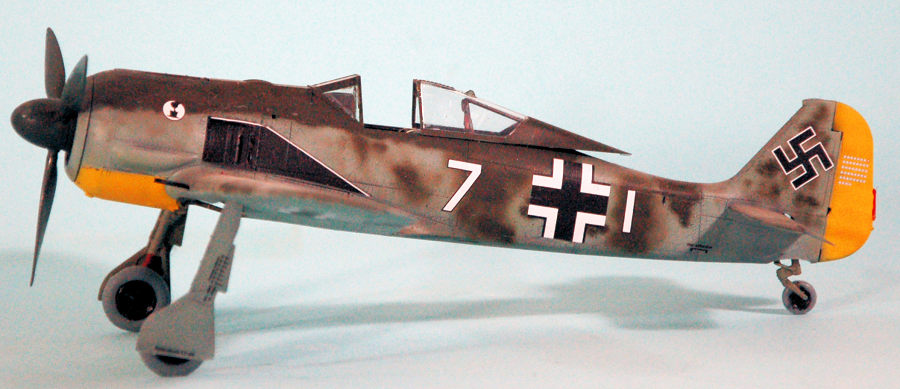
Eduard 1/48 FW-190A-2
| KIT #: | 82146 |
| PRICE: | $49.95 SRP |
| DECALS: | Five options |
| REVIEWER: | Tom Cleaver |
| NOTES: | Profipack |

| HISTORY |
From the outset of its development, the Fw-190 presented difficulties due to the designer’s decision to create the tightest cowling possible for the radial engine powerplant, in order to streamline the aircraft as much as possible. The hottest points on any air-cooled engine are the cylinder heads. In order to provide sufficient air to cool the engine, airflow had to be maximized at this outer edge. This was normally accomplished by leaving the majority of the front face of the engine open to the air, causing considerable drag.
Tank sought to change this with a ducted spinner on the first prototype, which was not successful. Throughout further prototype development, considerable effort was placed on developing a cooling system that would bring down the temperature of the rear row of cyulinders. Eventually, the first operational unit, I/JG 26, which received Fw-190A-1s in late summer 1941, became involved with this. The overheating problem for the rear of the engine was so severe that it could have resulted in cancellation of the entire program.
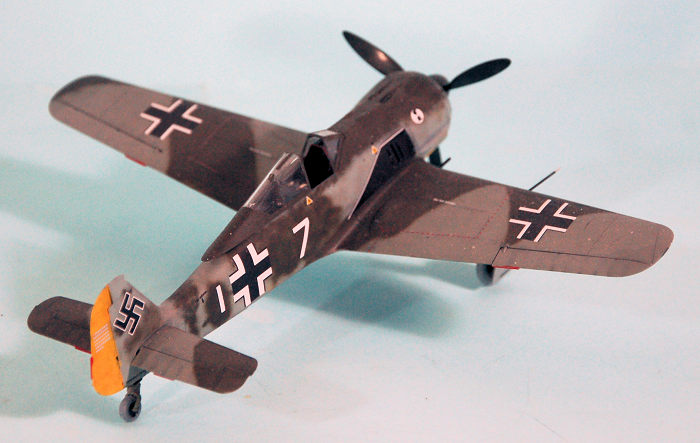 The result
was a large cooling fan in front, with multiple exhaust stacks coupled with
cooling vents. With the overheating solved, the Fw-190A-1 was replaced in
production by the Fw-190A-2 in the fall of 1941. Where the A-1 was armed with
four 7.62mm MG-17 machine guns in the upper cowling and inner wing, the wing
armament was changed to a 20mm MG 151 in each inner wing. Late in the aircraft’s
production run, the armament was increased with a 20mm MG-FF cannon placed in
the wing outboard of the landing gear. The engine was changed from the BMW
801C-1 to the C-2, with the same horsepower as the C-1, 1,539 hp.
The result
was a large cooling fan in front, with multiple exhaust stacks coupled with
cooling vents. With the overheating solved, the Fw-190A-1 was replaced in
production by the Fw-190A-2 in the fall of 1941. Where the A-1 was armed with
four 7.62mm MG-17 machine guns in the upper cowling and inner wing, the wing
armament was changed to a 20mm MG 151 in each inner wing. Late in the aircraft’s
production run, the armament was increased with a 20mm MG-FF cannon placed in
the wing outboard of the landing gear. The engine was changed from the BMW
801C-1 to the C-2, with the same horsepower as the C-1, 1,539 hp.
The first operational use of the Fw-190A-2 was in Operation Cerberus, the defense of the Channel Dash, in which the JG 26 fighters provided cover for the Scharnhorst, Geneisenau and Prinz Eugen and their escorts, in a dangerous trip through the English Channel to return to Germany from Bordeaux.
As more Fw-190s became available, JG 2 on the Cotentin Peninsula also re-equipped with the new fighter. RAF pilots who reported run-ins with the new radial-engined opponent were told these were former Armee de l’Air Hawk 75s, a claim that was met by derision on the part of pilots who were being outflown by their opponents.
The
Fw-190A-2 was replaced on the production line by the A-3, which was similar to
the late-production A-2 other than its use of a BMW 801D-2 engine that provided
150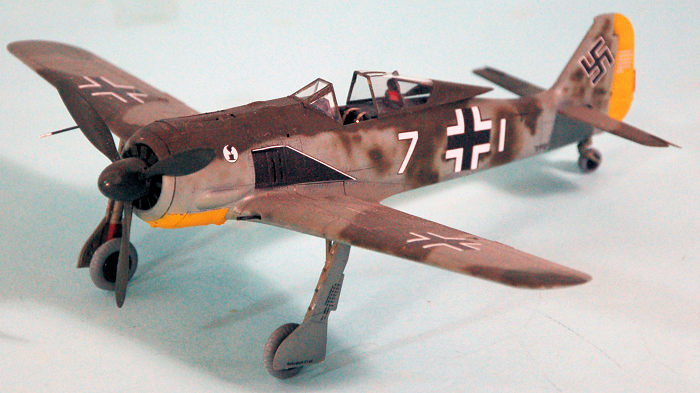 more horsepower. This was the first Wurger to see mass production as
production expanded to additional factories from the original Focke-Wulf
facility at Cottbus.
more horsepower. This was the first Wurger to see mass production as
production expanded to additional factories from the original Focke-Wulf
facility at Cottbus.
Egon Mayer:
Hauptmann Egon Mayer, the first German fighter pilot to score 100 victories, all on the Channel Front, joined the Luftwaffe in 1937. He was promoted to Leutnant and assigned to JG 2 on August 1, 1939, just before the outbreak of war. Scoring one victory in June 1940 in the Battle of France , he scored four more in the Battle of Britain - where he often flew as Helmut Wick’s wingman. He was promoted to Obertleutnant and assigned as Staffelkapitän of 7./JG 2 in June 1941, with 18 victories. He was awarded the Knight’s Cross on August 1, following his 20th victory.
Flying the Fw-190 from February 1942, Mayer and Georg-Peter Eder were responsible for developing the “Twelve O’Clock High” frontal attack maneuver for use against USAAF four-engine bombers. He was promoted to Hauptmann and made Gruppenkommandeur of II/JG 2 in November 1942. On November 23, he opened his score against the USAAF by shooting down two B-17s and a B-24. He was appointed Geschwaderkommodore of JG 2 on July 1, 1943.
 On
June 22, 1943, Mayer encountered Robert S. Johnson, a future ace of the 56th
Fighter Group. Johnson's P-47 Thunderbolt had been badly shot-up in a previous
combat. As he limped home, with a canopy that would not open and hydraulic fluid
and oil covering his windscreen, Mayer pulled alongside, then circled to give
the P-47 the coup de grâce. He was out of 20mm ammunition and had only the two
MG-17s. The first gun pass failed andMayer made two more runs without success.
Now out of ammunition, Mayer pulled alongside Johnson, saluted him and headed
for home. When Johnson managed to land at Manston, more than 200 holes were
counted in the Thunderbolt, without even moving around the airplane.
On
June 22, 1943, Mayer encountered Robert S. Johnson, a future ace of the 56th
Fighter Group. Johnson's P-47 Thunderbolt had been badly shot-up in a previous
combat. As he limped home, with a canopy that would not open and hydraulic fluid
and oil covering his windscreen, Mayer pulled alongside, then circled to give
the P-47 the coup de grâce. He was out of 20mm ammunition and had only the two
MG-17s. The first gun pass failed andMayer made two more runs without success.
Now out of ammunition, Mayer pulled alongside Johnson, saluted him and headed
for home. When Johnson managed to land at Manston, more than 200 holes were
counted in the Thunderbolt, without even moving around the airplane.
By the time of his death in combat in March 1944, Egon Mayer had a score of 102 in 353 combat missions, including 26 B-17 and B-24 bombers, 51 Spitfires, 12 P-47s and five Typhoons, three in one combat.
| THE KIT |
 Eduard
originally had not planned on releasing earlier Fw-190A kits in the Profipack
series than the A-3. However, the Fw-190A-1 and A-2 were included in the Royal
Class release, and they then decided to release those later in Profipack. With
the release of this kit, there is only the A-1 left now to complete the early
Wurgers.
Eduard
originally had not planned on releasing earlier Fw-190A kits in the Profipack
series than the A-3. However, the Fw-190A-1 and A-2 were included in the Royal
Class release, and they then decided to release those later in Profipack. With
the release of this kit, there is only the A-1 left now to complete the early
Wurgers.
The kit is differentiated from the A-3 release by having a lower wing part for the two-gun wing, and an alternative 4-gun lower wing which was part of the A-3 and A-4 releases. Decals are provided for two early 2-gun wing A-2s and three 4-gun wing airplanes. One of the 2-gun wing alternatives is the Fw-190A-2 flown by Egon Mayer in early 1942 as Staffelkapitän of 7./JG 2 , which was my choice for this project.
| CONSTRUCTION |
The kit assembles as all the other early Fw-190As. A modeler should be sure to smooth off all sprue nubs from the parts, due to the extremely close fit. A light scrapedown of the cannon bay door on the upper wing parts will insure easy fit of the wing sub-assembly to the fuselage sub-assembly.
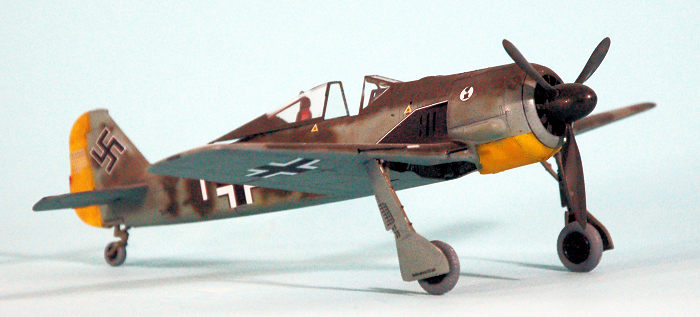 I was
supplied with the new LOOK instrument panel. This provides the detail of a
photoetch panel with the 3-D look of the plastic part using decals for the
instruments. It is very realistic, far moreso than either photoetch or plastic
alone. Unfortunately, given the geometry of the Fw-190 cockpit, it is very
difficult to see all this fantastic detail once the cockpit is assembled and the
fuselage is closed up. I think for the Fw-190 it is more than one needs, but on
models like the Bf-109s or Spitfires, or the coming P-51D, where the instrument
panel is not shrouded like that of the Fw-190, the LOOK instrument panel would
be a real addition to the detail of the model.
I was
supplied with the new LOOK instrument panel. This provides the detail of a
photoetch panel with the 3-D look of the plastic part using decals for the
instruments. It is very realistic, far moreso than either photoetch or plastic
alone. Unfortunately, given the geometry of the Fw-190 cockpit, it is very
difficult to see all this fantastic detail once the cockpit is assembled and the
fuselage is closed up. I think for the Fw-190 it is more than one needs, but on
models like the Bf-109s or Spitfires, or the coming P-51D, where the instrument
panel is not shrouded like that of the Fw-190, the LOOK instrument panel would
be a real addition to the detail of the model.
These Fw-190 kits are perhaps the easiest-assembling Fw-190 kits ever. If you take care in assembly, you will not need filler anywhere.
| COLORS & MARKINGS |
Eduard
calls out the camouflage for the airplanes in this kit as being RLM 74/75/76.
This is incorrect for the Fw-190A-2 and early A-3 aircraft. The correct
camouflage is RLM 65 for the lower surfaces and RLM 71/02 on
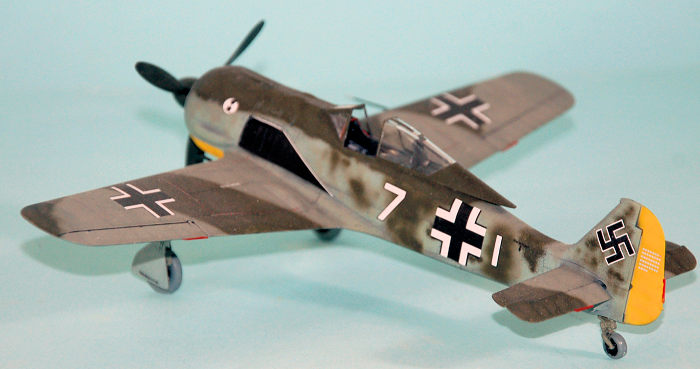 the upper surfaces.
After pre-shading the model with black along the panel lines, I painted the
lower cowling and the rudder with RLM 04 Yellow, then masked off those areas. I
used my last bottle of Gunze-Sangyo RLM 65 Hellblau for this, with Tamiya RLM 02
lightened to the proper shade, and Tamiya “Dark Green” which is RLM 71. The
camouflage pattern was freehanded with my Paasche-H airbrush, following the
color three-view in the instruction booklet.
the upper surfaces.
After pre-shading the model with black along the panel lines, I painted the
lower cowling and the rudder with RLM 04 Yellow, then masked off those areas. I
used my last bottle of Gunze-Sangyo RLM 65 Hellblau for this, with Tamiya RLM 02
lightened to the proper shade, and Tamiya “Dark Green” which is RLM 71. The
camouflage pattern was freehanded with my Paasche-H airbrush, following the
color three-view in the instruction booklet.
I used the kit decals, which are printed by Cartograf, to create the Fw-190A-2 flown by Egon Mayer, which has an interesting field-applied blotch camouflage on the fuselage.
I assembled the landing gear and attached it to the model. I really like how Eduard designed these parts so they only fit in the proper alignment, which gets rid of the major failure of Fw-190 models, whether built by experts or novices. I unmasked the canopy and glued it in the open position.
| CONCLUSIONS |
It’s another Eduard Fw-190 - what’s not to like? These kits really are the best kits of the Wurger available in 1/48. They are highly detailed and the production design of the kit leads to ease of assembly - the opposite of their earlier Wurgers. Everything about these kits is quality, and the Profipack release gives you everything you need in terms of aftermarket details. Any modeler from beginner to expert can get a superb result by committing the radical act of following the instructions. Highly recommended.
28 February 2019
Review kit courtesy of Eduard.
If you would like your product reviewed fairly and fairly quickly, please contact the editor or see other details in the Note to Contributors.